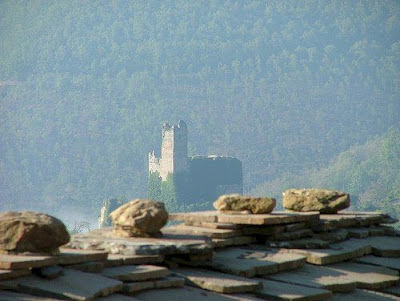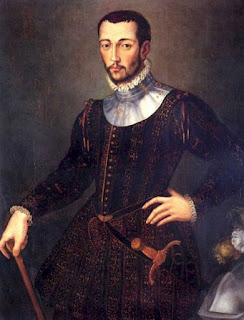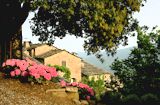 |
| Castello di Pierle as viewed from Borgo di Vagli |
Dating from October 1098, the first documentary evidence for the existence of a "Rocca di Pierle" is the will of Enrico, son of Ugo, Marchese di Monte Santa Maria, who, having fallen seriously ill in his castle of Pierle mentions it among his legacies. From then on control of Pierle bounced back and forth between Cortona and Perugia with periods of effective independence in between. In 1202, after a period of prosperity, the Marchesi del Colle (Monte Santa Maria) were forced to surrender the castle to Perugia due to famine. Just a few years later, in 1217, we find the Marchesi del Colle submitting to the lords of Cortona, who then took control of Pierle. In 1225, the Oddi of Perugia came into possession of Pierle thereby removing it from the control of Cortona. By 1236, Pierle once more belonged to the Casali, lords of Cortona, but at some stage it reverted to the Oddi family. By 1325, we read that the Casali family were ruling Cortona without being accepted by populace. The Casali had the title of "vicari imperiali" and exercised power in large part for their own benefit. Subsequent events indicate that they continued in this vein for several decades. On the 11th of August 1369, the peasant farmers of Pierle rebelled and assaulted the palazzo of the Casali in Mercatale and looted the storehouses. (A foretaste of the revolt of the Ciompi in Florence, nine years later.) As a result of this, the Oddi of Perugia decided to dispose of the assets they held in the Valdipierle and they sold the castles of Pierle and Lisciano to Francesco Casali. This event is recorded in their accounts of 1370.
 |
| The Castle of Pierle as rebuilt in 1371. |
Four years later, on the 26th of July 1375, Francesco Casali died and his powers were transferred to his son Nicoló Giovanni, who was only nine years old. In 1384, Nicoló Giovanni died of the plague and was succeeded as ruler of Cortona by his eight year old brother Francesco Senese Casali, under the tutelage of Ilario Grifoni. In 1387, Uguccio Casali became lord of Cortona by removing Francesco Senese from power on the grounds that he was not old enough to rule and nor to fight against neighboring Perugia. Uguccio Casali fought vigorously against the lords of Perugia and in 1394 conquered the Castle of Pugnano, capturing and imprisoning in Pierle the Marchese Carlo degli Oddi and his children. On the 11th October 1400, Uguccio Casali died and was succeeded at Cortona by Francesco Senese Casali. This latter was murdered seven years later and Aloigi Battista became the new lord of of Cortona. Aloigi Battista was removed from power on the 3rd June 1409 by Ladislaus the Magnanimous, King of Naples, when he conquered Cortona.
In 1411, the castle passed to the Florentine Republic which acquired it from King Ladislaus for 1200 florins, together with Cortona for 60,000 florins. For the next 165 years, the Castle of Pierle followed the fate of the Florence and its lords, the Medici.
 |
| Grand Duke Francesco I de' Medici |
In 1576, Grand Duke Francesco I ordered the destruction of the Castello di Pierle to prevent it from becoming a nest of evildoers, "vi si annidassero i malfattori". Such was the fate of one of the most beautiful and powerful examples of a feudal castle in Tuscany.
It's interesting to ponder the thought that Borgo di Vagli and its inhabitants have looked out over these changes for almost as long as the Castello di Pierle has existed. The reason this is so is, of course, that Pierle Castle needed a network of watch towers to protect it from attacks coming down from the mountains behind. One of these towers was the first building (14th century) at Borgo di Vagli and now houses its candlelit Trattoria.
More about the castles of Tuscany.
|
||||||
Fulvio Di Rosa
All content copyright © Fulvio Di Rosa 2013. All rights reserved.





